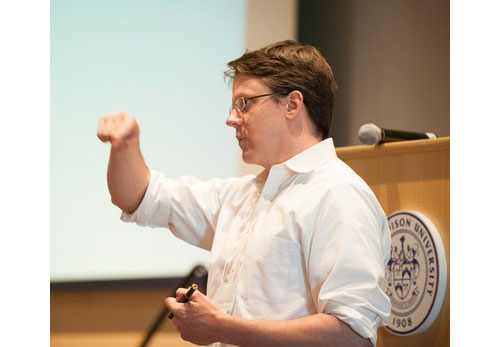Location
Harrisonburg, VA
Start Date
16-5-2012 4:00 PM
End Date
16-5-2012 4:20 PM
Description
Protein structure and dynamics form the platform on which almost all biomedical research is currently based, including hot topics like computer-aided drug design and established problems like creating a cure for cancer. Since most proteins are too small to visualize with even an electron microscope, biochemists must use either NMR spectroscopy or x-ray diffraction to determine what the structures look like. In my lab, we combine both techniques to describe fundamentally how normal and mutated proteins behave in muscle cells. We are specifically interested in the structural protein obscurin. This giant muscle protein helps to organize muscle cells, sense muscle injury, and provide support for force generation; it is necessarily both flexible and strong. Here I will talk about ongoing efforts to solve the high-resolution protein structures of discrete regions of obscurin, and how each of these domains encodes specificity to specific binding partners. I will also discuss the shape of the entire obscurin molecule in solution, and how dynamics of this system likely contributes to normal muscle physiology.
Presenter Bio
Nathan Wright Assistant Professor, Chemistry & Biochemistry, James Madison University
Nathan Wright received a B.S. in Biology at Haverford College in 2000, an M.S. in Cellular and Molecular Biology at the University of Pennsylvania in 2002, and at Ph.D. in Biochemistry at the University of Maryland, Baltimore with Dr. David Weber in 2008. He completed his postdoctoral training in structural biology at the University of Maryland and at Johns Hopkins University with Dr. Joel Schildbach in 2011. He is currently an Assistant Professor at James Madison University in the Chemistry and Biochemistry department. Dr. Wright’s main research interests are in the structure, dynamics and function of muscle proteins.
Included in
High & Low Resolution Techniques to Solve Protein Structures
Harrisonburg, VA
Protein structure and dynamics form the platform on which almost all biomedical research is currently based, including hot topics like computer-aided drug design and established problems like creating a cure for cancer. Since most proteins are too small to visualize with even an electron microscope, biochemists must use either NMR spectroscopy or x-ray diffraction to determine what the structures look like. In my lab, we combine both techniques to describe fundamentally how normal and mutated proteins behave in muscle cells. We are specifically interested in the structural protein obscurin. This giant muscle protein helps to organize muscle cells, sense muscle injury, and provide support for force generation; it is necessarily both flexible and strong. Here I will talk about ongoing efforts to solve the high-resolution protein structures of discrete regions of obscurin, and how each of these domains encodes specificity to specific binding partners. I will also discuss the shape of the entire obscurin molecule in solution, and how dynamics of this system likely contributes to normal muscle physiology.



